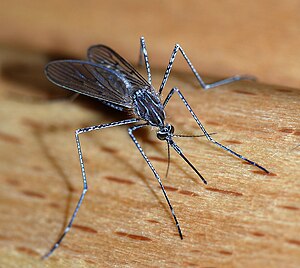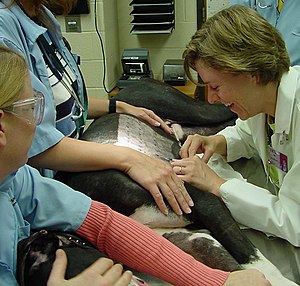Any person in contact with an infected animal may acquire a zoonotic disease, however, certain individuals are more at risk. People with compromised immune systems such as
pregnant women, the elderly, or people undergoing treatment for cancer are much more likely to contract the disease. Children are also more at risk due to immature immune systems and poor sanitary practices.
The following zoonotic diseases are just a few of the many that exist.
 Roundworms: Nearly every puppy or kitten is born with roundworms contracted from its mother. These worms can be transmitted to people, especially children. Most infections in people are so mild as to cause no signs at all, but the potential for severe illness exists. Migrating worms may damage the liver, eyes or brain. As the eggs are found in an animal’s stool, sanitation is essential; feces should be removed and disposed of daily and everyone who handles the animal should wash their hands.
Roundworms: Nearly every puppy or kitten is born with roundworms contracted from its mother. These worms can be transmitted to people, especially children. Most infections in people are so mild as to cause no signs at all, but the potential for severe illness exists. Migrating worms may damage the liver, eyes or brain. As the eggs are found in an animal’s stool, sanitation is essential; feces should be removed and disposed of daily and everyone who handles the animal should wash their hands. A very effective way to protect your family from roundworms is to use year ‘round heartworm preventative that also treats intestinal worms. These tablets deworm your pet each month as well as providing protection against heartworms.
Rabies: Anyone who saw the movie "Old Yeller" knows that rabies is a zoonotic disease. Rabies is caused by a virus transmitted through animal saliva. In Iowa, the most common carrier of rabies is the skunk while the raccoon is the most common on the East coast. Signs of rabies include personality and behavioral changes, incoordination, difficulty swallowing, seizures, and death. Rabies is fatal -- there is no cure in man or animals. Protect yourself by not handling wild or stray animals and by having all your dogs and cats vaccinated against rabies.
Bats are also a potential source of rabies infection. While most bats do not carry rabies, CDC guidelines recommend testing of any bat found in a room with a sleeping person, or someone unable to communicate whether they might have been bitten, such as an infant or an incapacitated adult. If you think you, or a member of your family might have been exposed to a bat under these circumstances, call your physician and explain the situation.
Toxoplasmosis: Toxoplasmosis is caused by a protozoan, a one-celled parasite. Hunting cats often contract this parasite by eating small rodents, and then shed the cysts in their stool. The parasite is also found in raw meat. Most cats and people show no signs of the disease, or have only mild flu-like symptoms. Those who have a weakened immune system may develop a much more serious infection. Fetal infection, especially during the first three months of pregnancy, can result in blindness, so pregnant women must take special precautions to avoid contacting toxoplasmosis cysts. Protect yourself by not letting your cat hunt and not feeding it raw meat. Pregnant women and persons with compromised immune systems should wear gloves when gardening, wash thoroughly after handling raw meat, and should not change litterboxes.
Although the chances of getting a zoonotic disease from your pet are slim, you should be aware that it could happen. The most effective way to prevent zoonotic diseases and ensure your good health is to ensure good health for your pets. Contracting a pet-borne disease usually requires very close contact with animals or their excretions, so zoonotic diseases can be avoided with common sense, cleanliness and regular pet examinations and vaccinations. For more information on zoonotic diseases, talk to your veterinarian, your physician, the public health department, or search reputable internet sites such as the CDC Healthy Pets Healthy People.
Chad Smith, D.V.M.

















![Reblog this post [with Zemanta]](http://img.zemanta.com/reblog_e.png?x-id=e3c13605-b6f9-40f9-88e0-e6637487d683)



![Reblog this post [with Zemanta]](http://img.zemanta.com/reblog_e.png?x-id=afc86638-57b8-42af-9c6a-c546d558b42e)




![Reblog this post [with Zemanta]](http://img.zemanta.com/reblog_e.png?x-id=0c0f2007-2ed2-426a-9efe-dd63f6c8ed5b)
![Reblog this post [with Zemanta]](http://img.zemanta.com/reblog_e.png?x-id=35f0122d-67b8-4473-94c8-327a06959f7a)
![Reblog this post [with Zemanta]](http://img.zemanta.com/reblog_e.png?x-id=ee522a65-3674-4eb4-8240-1dfcd9b3e94d)

![Reblog this post [with Zemanta]](http://img.zemanta.com/reblog_e.png?x-id=b51d7169-b0f6-473e-9c78-de4e42f1532c)



![Reblog this post [with Zemanta]](http://img.zemanta.com/reblog_e.png?x-id=d233b7b0-441f-4ac0-8851-731f3b125dcb)



![Reblog this post [with Zemanta]](http://img.zemanta.com/reblog_e.png?x-id=c33a5aa8-a6ed-46ea-a525-a85cd03dcb37)

